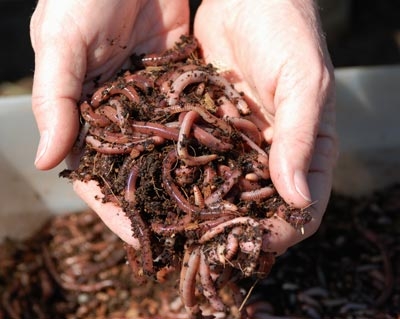Friend or Foe?
Earthworms: Friends in Low Places
By Jenny Kishiyama, Fairfax Master Gardener Intern
As I was pulling weeds and tidying up the wilder areas of my yard, I noticed earthworms zipping out of the ground to be out of harm’s way. Who knew they were so fast! Intrigued, I wondered how fast they could travel. I never did find out, but I learned many other fascinating things.

Lumbricus terrestris
There are approximately 2,700 earthworm species all working as natural recyclers. They are separated into three ecological categories based on their feeding and burrowing habits:
- Epigeic: Leaf litter- or compost-dwelling worms are non-burrowing and feed mainly on organic matter. They are adapted to the highly variable moisture and temperature conditions at the soil surface.
- Endogeic: Topsoil-dwelling worms feed on soil that has partially decomposed organic matter already incorporated. They create horizontal burrows in the upper 4 to 12 inches of soil.
- Anecic: These subsoil-dwelling worms construct permanent vertical burrows 5 to 6 feet deep. They ingest substantial amounts of soil but need surface litter to live, pulling it down into their burrows to feed on.

Red worms used for compost
The Lumbricus terrestris or “nightcrawler,” is one of the most common earthworm species in the U.S. and falls in the anecic (meaning “reaching up”) category. These are not suited to vermicomposting –they prefer digesting soil and will die from exhaustion trying to tunnel out of a composting container. Earthworms were introduced from Europe during colonial times through soil in potted plants. Their presence in large numbers is considered a good indicator of soil health, which in rich soil can be well over a million earthworms per acre.
Aside from being great food for birds and mammals, earthworms do great things for soil. The sticky slime they secrete to stabilize their burrows contains nitrogen, providing plant roots a readily available nutrient as well as paths for deeper growth. The burrows increase the soil’s water-holding capacity and ability to drain, helping to decrease surface water runoff and erosion. Soil that passes through the earthworm’s gut and excreted as casts (poop) has been shown to contain much more available potassium and phosphorus, along with microorganisms that stimulate the microbial activity in soil, that converts other nutrients into forms more readily used by plants. And the list goes on.
Like all living creatures, they have preferred habitats. Adding compost or other organic materials to your soil, leaving plant roots in your garden after harvest and keeping your soil moist will attract them. Practices that hurt earthworms are fertilizers or chemicals that make the soil acidic, and major soil disturbances like tilling, that upset the soil structure and eliminate existing burrows.
Understanding how and why earthworms are so important has made a fan out of me. I plan to make and keep them as friends in my yard!
Resources
• Soil Biology Chapter 8: EARTHWORMS, Clive A. Edwards, The Ohio State University
• Earthworms, Sjoerd Willem Duiker, Richard Stehouwer, Pennsylvania State University Extension
• Earthworm, Wikipedia
• Did you know … Earthworms, Louisiana Department of Environmental Quality
• Kinematic scaling of locomotion by hydrostatic animals: ontogeny of peristaltic crawling by the
earthworm lumbricus terrestris, K.J. Quillin, Journal of Experimental Biology, March 1999